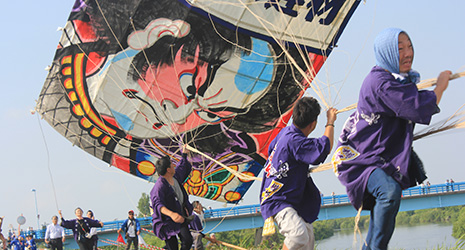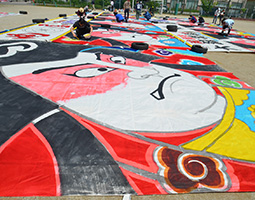March 2020
Giant Kites Battle On with Local Energy

The Shirone Giant Kite Battle in Niigata City, Niigata Prefecture, in which two neighboring communities do battle using giant handmade kites, is still going strong after 300 years.

Every year in early June, the people of Minami Ward, Niigata City, hold a stirring festival in which teams living on the west bank of the river do battle with teams living on the east bank using giant kites. The Shirone Giant Kite Battle draws more than 200,000 spectators over the five days of the festival.
The stage for the Kite Battle is the 80-meter-wide Nakanokuchi River, which flows north to south through Minami Ward. Members of the east team from Minami Ward’s Shirone district and west team from the Ward’s Nishi-Shirone district run with their kites along their opposing riverbanks, pulling the kites into the air with thick ropes called motozuna. By design, the giant, height 7 by width 5 meter kites soon become entangled and fall in to the river. After the teams have entangled the motozuna and other connecting ropes still further using the force of the river current, a tug of war begins, with the team that snaps the opponent’s ropes winning the bout. Multiple bouts are held over the course of the festival. These days a time limit is set for each bout, but on one occasion in the past, when no time limit was set, a battle was only declared a draw at sunset after over 4 hours of intense tug of war.
Abe Ryuichi, secretary-general of the Shirone Association for Battle of Giant Kite, says, “There are various views about the origins of the festival, but it is said that it began when a kite flown by people from the Shirone side of the river crashed in a field on the Nishi-Shirone side, damaging the crops. Angered, the people on the Nishi-Shirone side retaliated by crashing a kite on the Shirone side. Whatever the origin, I think the main reason why the festival has continued is that raising kites into the air makes everyone feel cheerful. In the past, houses and farms were repeatedly damaged by floods in the expansive swampy lowlands of the Niigata Plains. For that reason alone, it seems that this grand festival, held once a year along the river, must have been the most enjoyable social event.”
The giant kites used in the battle are made by stretching Japanese washi paper over a bridle of vertical and horizontal bamboo spars. The washi paper is essential for making the giant kites, as it is strong and lightweight. Nowadays long, rolled-up sheets of washi paper are used, but in the past the kites were made by combining 324 sheets of small 46 by 32 centimeter pieces of washi paper. Abe says, “Modern paper made from pulp has a fiber orientation, or ‘grid,’ and it can be easily cut when pressure is applied along the fibers. However, with washi paper, the fibers of the kozo paper mulberry plant are intertwined in a complex way, lacking a grid. It is the best material for making giant kites that can rise up and harness the power of strong wind, as the paper is hard to tear no matter which direction force is applied.”
Currently, six east teams and seven west teams from each neighborhood association participate in the Shirone Giant Kite Battle, with the 30 to 50 members from each team taking one year to build 25 to 30 giant kites each. According to Abe, the distinguishing feature of the Shirone giant kites is the fact that they are made entirely by hand from natural materials, from the bamboo spars for the kite frame to the 130 meter long, 2.5 centimeter thick motozuna, which are each made from 40 kilograms of domestically produced hemp. The vivid illustrations on the kites depicting samurai, butterflies, fish and other motifs, are also hand-drawn. Local people deepen their relationships through this work, which takes more than 6 months to complete.

There are master kite builders in the Shirone district, and in 1980 they created a massive, height 19 by width 14 meter kite which they were able to fly, making it the largest kite in the world at that time according to Guinness World Records.
Abe says, “An issue going forward is the passing on of techniques, as the birthrate is decreasing and the population is aging in the region. Among the 13 east and west teams, some don’t have enough successors or people to help out, so we are very open to participation by people from outside the Shirone district and non-Japanese people, as well. Before a festival, on a weekend in April with good weather, we lay out the giant kites in the elementary school yard and paint them all at once. Many people participate in the creation process in this way, and I hope people enjoy the giant kites of Shirone on this day as well as on the day of the festival.”


